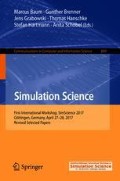Abstract
Evaluations of Internet of Things (IoT) and Wireless Sensor Network (WSN) applications demonstrate the significant and still existing gap between examinations with generic simulation environments and real-life (e.g., field test) or controlled (e.g., testbed) sensor network deployments in terms of realistic and accurate results. The separated use of single examination approaches is often not enough to overcome all evaluation challenges. We therefore propose a combination of discrete-event simulation, radio-channel emulation, and real hardware working together on different layers of the protocol stack of the system-under-test. Our combined approach reduces the gap between abstract simulations and network testbed experiments by providing adjustable radio conditions for repeatable evaluations of WSN and IoT networks.
Access this chapter
Tax calculation will be finalised at checkout
Purchases are for personal use only
Notes
- 1.
INET framework website: https://inet.omnetpp.org/.
- 2.
RoSeNet radio channel emulation platform: https://www.dresden-elektronik.de/ingenieurtechnik/development/research/rosenet/.
- 3.
PCAPNG capture file format: https://github.com/pcapng/pcapng.
- 4.
ATmega128RFA1: http://www.microchip.com/wwwproducts/en/ATmega128RFA1.
- 5.
Wireshark network protocol analyzer: https://www.wireshark.org/.
- 6.
RCB128RFA1 Radio Controller Board: http://www.dresden-elektronik.de/funktechnik/products/reference-designs/atmel-radio-controller-boards/radio-controller-boards/.
- 7.
Texas Instruments (TI) CC2531: http://www.ti.com/product/CC2531.
- 8.
SmartRF Protocol Packet Sniffer http://www.ti.com/tool/PACKET-SNIFFER.
- 9.
Radiotap project website: https://www.radiotap.org/.
References
Imran, M., Said, A., Hasbullah, H.: A survey of simulators, emulators and testbeds for wireless sensor networks. In: International Symposium in Information Technology (ITSim). IEEE (2010). https://doi.org/10.1109/ITSIM.2010.5561571
Kropff, M., Krop, T., Hollick, M., Mogre, P.S., Steinmetz, R.: A survey on real world and emulation testbeds for mobile ad hoc networks. In: Proceedings of the 2nd International Conference on Testbeds and Research Infrastructures for the Development of Networks and Communities (TRIDENTCOM), 6-pp. IEEE (2006). https://doi.org/10.1109/tridnt.2006.1649182
Göktürk, E.: Emulating ad hoc networks: differences from simulations and emulation specific problems. In: Tugcu, T., Gelenbe, E., Caglayan, M.U. (eds.) New Trends in Computer Networks. Advances in Computer Science and Engineering: Reports, vol. 1. Imperial College Press, October 2005
Wehrle, K., Güneş, M., Gross, J.: Modeling and Tools for Network Simulation, 1st edn. Springer, Heidelberg (2010). https://doi.org/10.1007/978-3-642-12331-3
Varga, A., Hornig, R.: An overview of the OMNeT++ simulation environment. In: Proceedings of the 1st International Conference on Simulation Tools and Techniques for Communications, Networks and Systems (SIMUTools), ICST, article no. 60 (2008)
Riley, G.F., Henderson, T.R.: The NS-3 network simulator. [4] Chapter 2, pp. 15–34. https://doi.org/10.1007/978-3-642-12331-3
OMNeT++ Manual: Function called for each event (2017). https://omnetpp.org/doc/omnetpp/manual/#sec:simple-modules:handlemessage:overview
Stehlik, M.: Comparison of simulators for wireless sensor networks. M.Sc. thesis, Faculty of Informatics, Masaryk University (2011)
Goldsmith, A.: Wireless Communications. Cambridge University Press, Cambridge (2005)
Dwivedi, A.K., Vyas, O.P.: An exploratory study of experimental tools for wireless sensor networks. Wirel. Sens. Netw. 3(7), 215–240 (2011)
Duan, S., Wan, Y., Meng, P., Wang, Q.: Hardware-in-the-loop and parallel simulation architecture for WSN. TELKOMNIKA 11(1), 103–114 (2013)
Mozumdar, M.M.R., Lavagno, L., Vanzago, L., Sangiovanni-Vincentelli, A.L.: HILAC: a framework for hardware in the loop simulation and multi-platform automatic code generation of WSN applications. In: International Symposium on Industrial Embedded Systems (SIES), pp. 88–97. IEEE (2010)
Papadopoulos, G.Z., Kritsis, K., Gallais, A., Chatzimisios, P., Noel, T.: Performance evaluation methods in ad hoc and wireless sensor networks: a literature study. IEEE Commun. Mag. 54(1), 122–128 (2016)
Österlind, F., Dunkels, A., Eriksson, J., Finne, N., Voigt, T.: Cross-level sensor network simulation with COOJA. In: Proceedings of the 31st IEEE Conference on Local Computer Networks (LCN), pp. 641–648. IEEE Computer Society (2006). https://doi.org/10.1109/LCN.2006.322172
Dunkels, A., Gronvall, B., Voigt, T.: Contiki - a lightweight and flexible operating system for tiny networked sensors. In: Proceedings of the 29th Annual IEEE Conference on Local Computer Networks (LCN), pp. 455–462. IEEE Computer Society (2004). https://doi.org/10.1109/LCN.2004.38
Sundani, H., Li, H., Devabhaktuni, V.K., Alam, M., Bhattacharya, P.: Wireless sensor network simulators a survey and comparisons. Int. J. Comput. Netw. (IJCN) 2(5), 249–265 (2011)
Du, W., Mieyeville, F., Navarro, D., O’Connor, I., Carrel, L.: Modeling and simulation of networked low-power embedded systems: a taxonomy. EURASIP J. Wirel. Commun. Netw. 2014(1), 1–12 (2014)
Wehner, P., Göhringer, D.: Internet of Things simulation using OMNeT++ and hardware in the loop. In: Keramidas, G., Voros, N., Hübner, M. (eds.) Components and Services for IoT Platforms, pp. 77–87. Springer, Cham (2017). https://doi.org/10.1007/978-3-319-42304-3_4
Kirsche, M., Schnurbusch, M.: A new IEEE 802.15.4 simulation model for OMNeT++/INET. In: Proceedings of the 1st International OMNeT++ Community Summit (OMNeT 2014), September 2014
IEEE Standards Association: Part 15.4: Wireless Medium Access Control (MAC) and Physical Layer (PHY) Specifications for Low-Rate Wireless Personal Area Networks (WPANs). IEEE Standards Document - Revision of IEEE Std. 802.15.4™-2006. IEEE, September 2006. https://doi.org/10.1109/IEEESTD.2006.232110
Kirsche, M.: Selected System Models - IEEE 802.15.4. [4] Chapter 12.3, pp. 276–303. https://doi.org/10.1007/978-3-642-12331-3
Böhm, S., Kirsche, M.: Looking into hardware-in-the-loop coupling of OMNeT++ and RoSeNet. In: Proceedings of the 2nd International OMNeT++ Community Summit (OMNeT 2015), September 2015
Tüxen, M., Rüngeler, I., Rathgeb, E.P.: Interface connecting the INET simulation framework with the real world. In: Proceedings of the 1st International Conference on Simulation Tools and Techniques (SIMUTools 2008), ICST, Brussels, Belgium, Belgium, pp. 40:1–40:6. ICST (2008). https://doi.org/10.1145/1416222.1416267
Acknowledgement
Parts of this work were funded by the German Federal Ministry for Economic Affairs and Energy (BMWi) through the Central Innovation Programme (ZIM initiative) under Contract No. ZF4119201ED5.
Author information
Authors and Affiliations
Corresponding author
Editor information
Editors and Affiliations
Rights and permissions
Copyright information
© 2018 Springer Nature Switzerland AG
About this paper
Cite this paper
Böhm, S., Kirsche, M. (2018). Unifying Radio-in-the-Loop Channel Emulation and Network Protocol Simulation to Improve Wireless Sensor Network Evaluation. In: Baum, M., Brenner, G., Grabowski, J., Hanschke, T., Hartmann, S., Schöbel, A. (eds) Simulation Science. SimScience 2017. Communications in Computer and Information Science, vol 889. Springer, Cham. https://doi.org/10.1007/978-3-319-96271-9_14
Download citation
DOI: https://doi.org/10.1007/978-3-319-96271-9_14
Published:
Publisher Name: Springer, Cham
Print ISBN: 978-3-319-96270-2
Online ISBN: 978-3-319-96271-9
eBook Packages: Computer ScienceComputer Science (R0)

